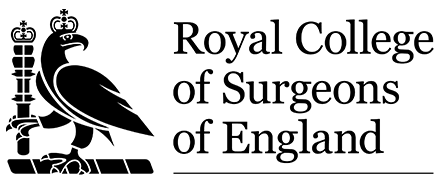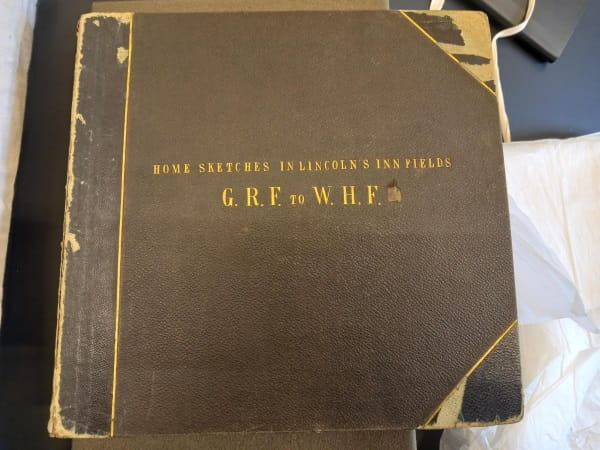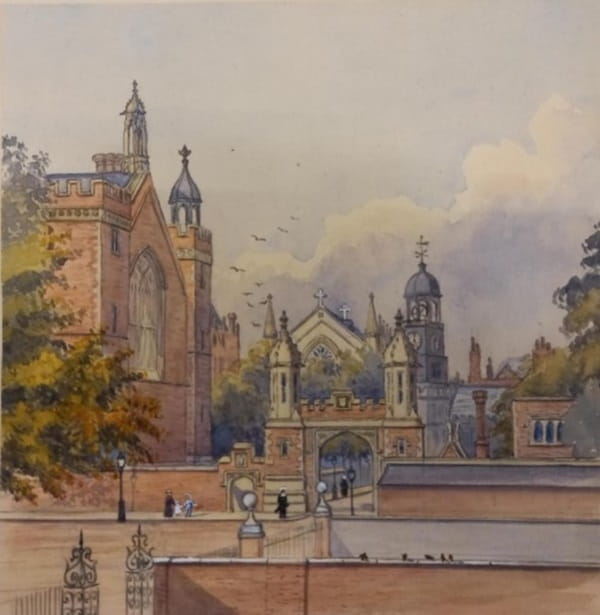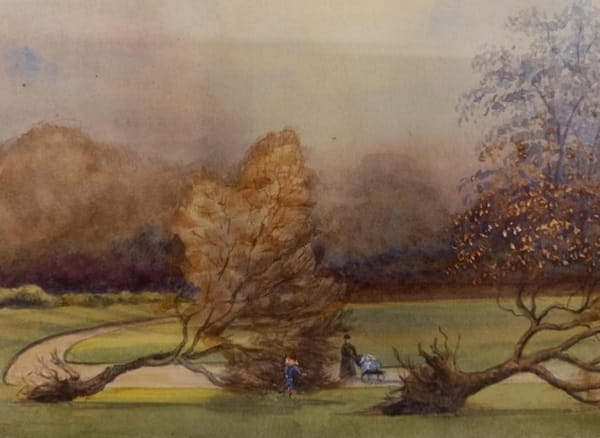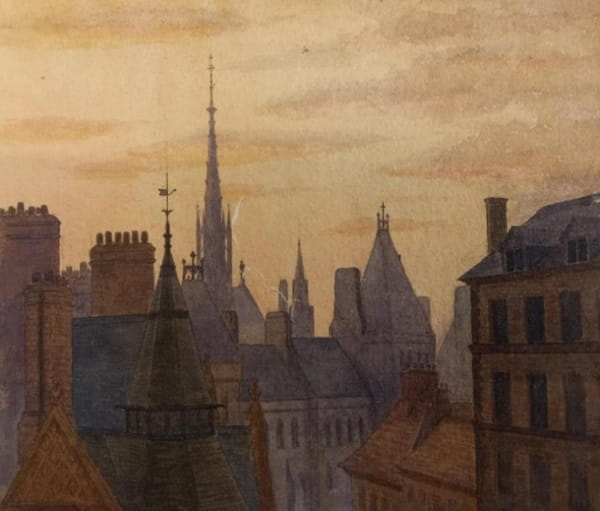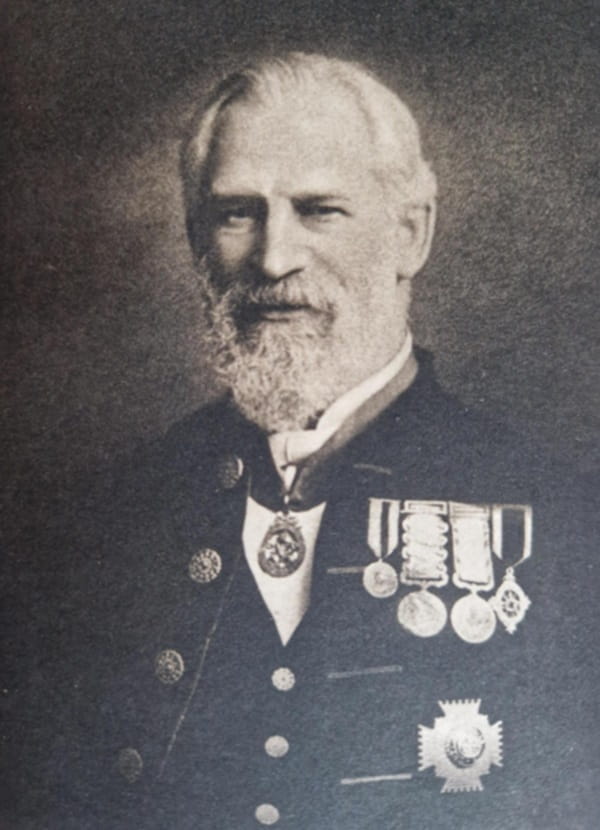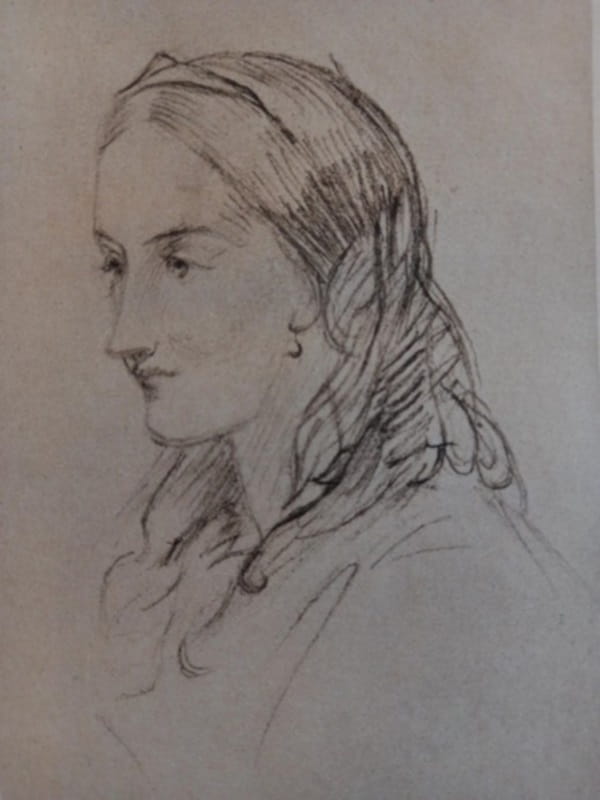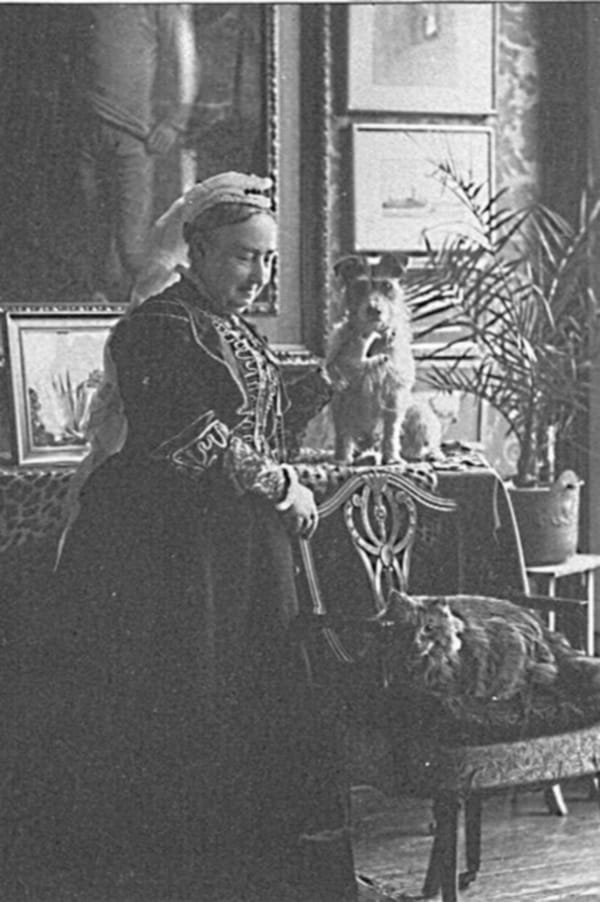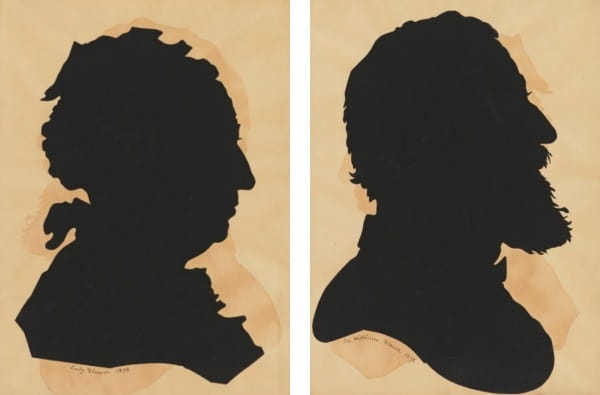Stories from Lincoln’s Inn Fields: The Flower Family
18 Oct 2023
Maria Christodoulou
In the RCS England archive, in box MS0012, among administrative papers, there is a brown leatherbound tome of home sketches. In gold letters it reads, “Home Sketches in Lincoln’s Inn Fields. G.R.F to W.H.F”. Inside, there is a series of watercolours of various points of view around Lincolns Inn Fields. These delicate sketches of urban landscape date from 1880–90 and belong to Lady Georgiana Rosetta Flower (1835–1923). The book was a gift to her husband Sir William Henry Flower; a gift of love without doubt but also a testimony of a life and partnership strongly bound in art and a sense of place. Below is a short story of the influential Flowers and their strong connection to the Royal College of Surgeons of England.
Above: The cover of Georgiana Rosetta Flower’s sketchbook (RSC England Archive item MS0012).
Above: Right-hand view from the College building (RSC England Archive item MS0012).
Above: View of Lincoln's Inn Fields from the College building (RSC England Archive item MS0012).
Above: London rooftops during sunset (RSC England Archive item MS0012).
Sir William and Lady Flower
Distinguished RCS fellow, Sir William Henry Flower KCB FRS FRCS FRAI (1831–1899), was an English surgeon, naturalist, comparative anatomist and a leading authority on mammals. He also served as museum curator, first as conservator of the Hunterian Museum at the Royal College of Surgeons and later as director of the Natural History Museum. His life’s work is noteworthy for its varied and innovative scientific and intellectual contributions. He was a polymath with many interests and proficient in both science and the arts.
He was born in Stratford-upon-Avon on November 30, 1831, the second son of Edward Fordham Flower and Celina, the eldest daughter of John Greaves, of Leamington. His father was founder of the well-known Stratford-on-Avon brewing business Flower & Sons. His elder brother, Charles, was the founder of the Shakespeare Memorial Theatre, and his younger brother was Chairman of the Shakespeare Birthplace Trustees.
Flower was educated at University College and graduated as an MB at the University of London in 1851 after studying at the Middlesex Hospital. At University College he won the Sharpey Gold Medal in Physiology and the Grant Silver Medal in Zoology. He started his career as house surgeon at the Middlesex Hospital and in 1854 passed the exam to become an MRCS (Member of the Royal College of Surgeons). Also in 1854 he became Curator of the Middlesex Hospital Museum.
He volunteered as a military surgeon during the Crimean War in 1854 and held a hospital appointment at Scutari. His health suffered substantially during the war and in recognition of his services, he received the Crimea Medal from Queen Victoria. After his return and recovery, he took the diploma to become an FRCS (Fellow of the Royal College of Surgeons) in 1857 and was elected Assistant Surgeon and Lecturer on Anatomy. In 1861 he became Conservator of the Museum of the Royal College of Surgeons of England, holding the post until 1884. He also served as Professor of Comparative Anatomy and Physiology at the College from 1870–1873 and a second time from 1876–1884. He was elected a Fellow of the Royal Society in 1864 and was awarded a Royal Medal in 1882. When Sir Richard Owen retired from the Directorship of the Natural History Museum, Flower was appointed in his place in 1884. He resigned from that post in 1898 due to ill health.
As a scientist, Flower was a morphologist and a comparative anatomist, as is shown by his important contributions to the anatomy of mammals and of the Cetacea. Foremost among Flower’s many thorough mammalian studies are those dealing with marsupials, whales, and primates. He was the first to show that lemurs are primates and, during extensive anthropological research, made complete and accurate measurements of at least 1,300 human skulls.
In the evolution debate he was outspoken in his support of Charles Darwin and his theory on the origin of species. He did not necessarily see the friction between science and religion as unavoidable and he approached religious belief and evolutionary theory syncretically. He understood his Christian faith as belonging to a separate plane than that of science, and that modern scientific developments hadn’t served to make him doubt that, in his own words, “the wonder and mystery of Creation remains as wonderful and mysterious as before” (Cornish, A Personal Memoir).
His chief publications are Diagrams of the Nerves of the Human Body (1861), An Introduction to the Osteology of the Mammalia (1870), Introduction to the Study of Mammals, Living and Extinct (1891), and Essays on Museums and Other Subjects (1898). The RCS England Library holds all the published works of this original thinker and prolific writer, in either physical or digital form. The RCS England Archives also holds related archival material. You can read more on his biography and career in his Lives of the Fellows obituary.
Above: Sir William Flower. Taken from: Cornish, A Personal Memoir.
He married Georgiana Rosetta Smyth in 1858, youngest daughter of Admiral William Henry Smyth (1788–1865), a well-known astronomer and one of the founders of the Royal Geographical Society. The wedding took place in Stone, in Buckinghamshire, near the bride’s home. This was, by all accounts, a happy marriage which had an important influence on both partners. They both shared a background of scientific and intellectual curiosity and an interest in life and people.
They also had in common an artistic talent and sensibility, they both sketched and loved art. William produced sketchbooks in which he recorded everything that struck him as being of interest: buildings, animals, natural scenery, everyday life, impressions from his journeys. Georgiana was also interested in and moved by her surroundings. With Lincoln’s Inn Fields as central reference point, her sketches present a romantic depiction of the city, evoking fragile beauty and tenderness. They travelled together extensively, beginning with their honeymoon in Flanders, Brussels, Louvain, and Rhine, the first of a series of journeys abroad together which formed an almost annual pleasure (Cornish, A Personal Memoir, page 43).
Lady Flower wrote of the first years spent in her husband’s company:
One of the great pleasures during this, our first journey together, was the beauty of the spring flowers abroad, where all the fruit-trees were in blossom, and listening to the birds in full song. My husband knew the notes of all, and delighted in teaching me to learn the different sounds or to identify their flights and movements. Our visits to the old historic towns, in which his interest in architecture, history, and the paintings of the old masters had full play, were equally delightful. His appreciation of these subjects remained and grew all his life, side by side with his master passion for science.
(Cornish, A Personal Memoir, page 44.)
Flower wrote of his marriage as “the most important and happiest event” of his life (page 44, A personal memoir). He expresses and reciprocates sentiments of love and devotion by dedicating his last work, entitled Essays on museums and other subjects connected with natural history (London: Macmillan, 1898), to his partner. The dedication reads as follows:
To her
Who for forty years
Has been my never-failing counsellor and support
In all difficulties and perplexities
This collection of fugitive thoughts
Upon subjects closely associated
With the greater part of our joint life’s work
Is lovingly dedicated.
Above: Sketch of Lady Georgiana Rosetta. Taken from: Cornish, A Personal Memoir.
Georgiana seemed to have been a strong presence and well-known personality of her time. Along with her husband in their “joint life’s work,” they maintained an active social life, hosting literary gatherings and over the years meeting many leading figures in British society and in the intellectual circles of their time. Among their friends were the poet laureate Alfred, Lord Tennyson and the leading churchman Dean Stanley.
William and Georgiana had four daughters and three sons, including the zoologist Stanley Smyth Flower (1871–1946). William died after some months of ill health at Stanhope Gardens on July 1st, 1899 with his wife and some of his children by his side. He gave detailed instructions for his body to be cremated in Woking, as he considered it a duty he owed to his fellow men as conducive to public health. His ashes were laid with his wife’s family at Stone, Buckinghamshire, in his own words, “beside the church where our life together began”. (Cornish, A Personal Memoir, London 1904, page 243) Georgiana passed away, at 87 years of age, on Sunday 7 Jan 1923 in Kensington, London and was also laid to rest in St. John the Baptist Churchyard, in Stone.
Above: “Lady Flower in 1908.” From WikiTree, public image uploaded by Anonymous Bethune, 2018.
Above left: “Jane Georgiana Rosetta (née Smyth), Lady Flower” by Francis Smyth Baden-Powell, silhouette, 1898 (NPG D424). Above right: “Sir William Henry Flower” by Francis Smyth Baden-Powell, silhouette, 1898 (NPG D423). Image credits: the National Portrait Gallery, licensed under Creative Commons Attribution-NonCommercial-NoDerivs 3.0 Unported.
The new museum idea:
Flower proved excellent as both a scientist and administrator, but it’s his work in museum curatorship that exemplifies his worldly, democratic, and modern approach to knowledge and society. His innovative work in museum arrangement as director of the two major institutions he served, proved authoritative for the field and served what he called the practical work of his life, the advancement of scientific knowledge through the development of museums.
He insisted on the importance of distinguishing between collections intended for the use of specialists and those designed for the instruction of the general public. He pointed out that it was practically useless to present to the expert merely typical forms, as well as futile to provide the untrained public with a long series of indistinguishable specimens, differing only in minute details. His ideas, which were largely and successfully applied to the museums of which he was in charge, gradually gained wide approval.
He also promoted wider access to museums and knowledge sharing. He believed that educated people needed to know more about current scientific developments, while ordinary people could benefit greatly by being exposed to new mental horizons and information. He seems to have personally conducted tours for groups across the social spectrum, from royalty to specialists and working men.
His success in the difficult task of making the museum interesting to the general public without destroying its utility for scientific students, led to him being justly pronounced as “an originator and inventor in museum work”, vastly improving methods of museum arrangement and management. He underpinned his practice by a theoretical foundation as expounded in his writings and particularly in Essays on Museums. According to the theories he developed, he argued for effective and attractive presentation by de-cluttering the exhibits, ensuring each specimen had an easy-to-read label, and placing each stuffed animal beside its skeleton and remains of its extinct allies in order to give the displays depth and context. He introduced in this way aesthetic considerations and thematic curation in museum work. His contributions to museum curatorship are of particular importance as they foreshadow the modern museum as a public space, as well as an accessible, permanent and beautifully arranged register.
In the above short story of the Flower family, the public and the personal are interwoven in dynamic and interesting ways. Perhaps not uncharacteristically of 19th century polymathy, they shared far and wide interests and passions, but also, the Flowers exhibited a sense of togetherness and devotion that did not necessarily belong in the public sphere. Their influence and connection to the College is well documented and the Library and Archive holdings record the traces of their lives and love.
Maria Christodoulou, Information Assistant
Sources:
- Georgiana’s watercolours, RCS England Archive item MS0012.
- Cornish, C. J. (1904). Sir William Henry Flower KCB FRS LLD DCL : a personal memoir. London: Macmillan and Co. Available from the RCS England Library.
- Flower, W. H. (1883). “Recent advances in natural science in their relation to the Christian faith: a paper read at the Reading Church Congress.” London: Bemrose & Sons.
- Lydekker, R. (1906). Sir William Flower. London: J.M. Dent & Co. Available from the RCS England Library.
- Obituary of Sir William Henry Flower in Plarr’s Lives of the Fellows.
- Flower, W. H. (1898). Essays on Museums. Available from the RCS England Library. A digital version can be found at the Internet Archive.
